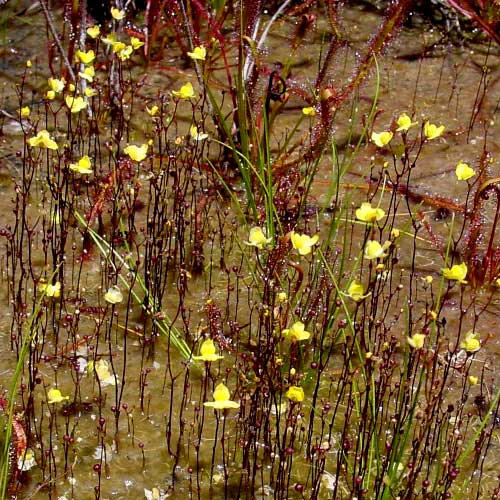
Growing Tips for Terrestrial Bladderworts



Terrestrial Bladderworts-Utricularia
Soil: 4:1 peat:sand.
Container: 4" plastic pot.
Watering: moist to very wet.
Light: full to part sun to dappled light.
Temperature: tropical to cold alpine, depending upon species.
Humidity: medium to high.
Location: windowsill, terrarium, greenhouse
Dormancy: No, for tropicals, Yes for temperates.
Habitat
Terrestrial Bladderworts, Utricularia, are the most common group of Carnivorous Plants and grow in a variety of biomes worldwide. Most terrestrial bladderworts grow in typical CP conditions of sunny, very wet, peaty soil. They are common Carnivorous Plants in bogs, pocosins, and fens. They frequently grow in association with sphagnum moss.
Culture
Most terrestrial bladderworts thrive in a standard Carnivorous Plant soil mix of 1 part sand and 1 part peat. Though the sand-peat ratio is not critical, most prefer a more peaty mix, and some prefer live sphagnum moss. Use mineral-free water and for most bladderworts, keep the soil very wet. The tray method works very well. Stand the pot in a tray or saucer and keep about 1/2 - 1” (1.2-2.5cm) of water in it at all times during the growing season. Most terrestrial bladderworts prefer full sun, but can tolerate shade. Some prefer indirect, low level light. Most terrestrial bladderworts do quite well at room temperature, but a few prefer very warm or cool conditions.
Propagation
Terrestrial Bladderworts can be propagated from leaf pulls, or divisions from the rhizome mat. Place both in water or damp peat. Seeds are slow and need steady conditons.
Dormancy
Species native to temperate zones require dormancy. They will die back in the late Fall. Dormant plants should be kept somewhat drier, but the soil should remain evenly moist. Tropical terrestrial bladderworts do not go dormant and will grow year round.
Feeding
Terrestrial bladderwort traps are underground and quite small. Their common “foods” are soil nematodes and protozoa. They do a marvelous job of attracting and catching prey all on their own. It is troublesome, difficult and unnecessary to feed them.
Other Considerations
Bladderworts are generally grown for their flowers. They spread rapidly and provide a lovely display. Several different species can be grown together.
Many terrestrial bladderworts will flower and go to seed readily. Some can even become “weeds” in a collection. The seeds are some of the smallest in the world and can be readily collected by shaking the flower stalk over a small dish.
Most terrestrial bladderworts will readily propagate from “root division.” Simply dig out a small portion of the plant and repot it in fresh, wet, bladderwort-free soil.
Terrestrial bladderworts can spread very quickly from pot to pot from seed. It is not unusual to have other Utricularia species intermix with one another.
Repot every few years in a fresh Carnivorous Plant soil mix, since the peat breaks down and can create poor drainage. This is a good time to divide the plant. This is best done in the Spring, before active growth begins.
Terrestrial bladderworts are excellent terrarium plants. Consider placing them in a vented terrarium under fluorescent lights with a timer set for 16 hours/day. The lights should be about 6” from the plants.
